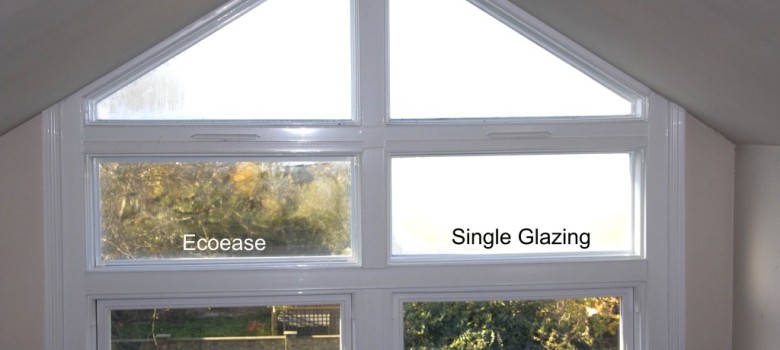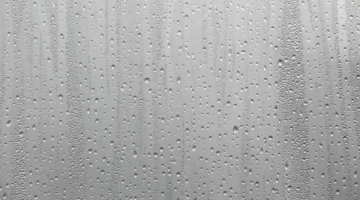
As soon as the temperature begins to drop outside and we start firing up our central heating systems, it is quite common to witness condensation appearing on windows throughout the home.
Many of us blame the “shoddy” windows and immediately think that replacing them is the only option, however this is certainly not the most cost effective approach to take.
Why does Condensation form on windows?
The reason condensation forms on the windows is pretty simple – basically the warm moist air circulating in the home comes into contact with cold windows and then the water condenses.
This can be particularly prevalent in bedrooms for example where you might have a couple of people breathing all night in an enclosed space, but other causes of condensation include showering, bathing, cooking and drying clothes.
Is Condensation on windows a problem?
On the whole, condensation isn’t really a problem – except that it is rather unsightly.
However prolonged condensation can lead to mould forming, which obviously is an issue, since it can cause health problems and damage furnishings. In addition, if water is in constant contact with timber elements of the property, such as the wooden frames around some windows, then the wood may begin to decay, which will be very costly to replace in the long run. Prolonged excess moisture also reduces the effectiveness of insulating materials, which means that you will be paying more for your heating costs.
A few solutions to combat condensation
Firstly you can replace all the windows – however this is the most costly solution. Retrofitting all your existing glazing with new double-glazed windows may set you back a whopping £20 to £30k (depending on the size of property and the number of windows). Most people don’t have that kind of money at hand.
You can leave the windows open – this ensures that the air can circulate and escape the home. The issue is that if it is zero degrees outside, why would you want to keep all your windows open?!
A dehumidifier can also stop condensation – this works by removing the excess moisture from the air – these are costly to buy however and also you need to pay to keep them running. Since they work relatively slowly you are going to need to keep these on pretty much constantly, and there is the constant emptying of the water out of the dehumidifying unit.
So, is there a better and more cost effective solution?
Ecoease secondary glazing – the cheaper alternative to double glazing.
Ecoease secondary glazing is a neat way you can reduce the window condensation problem as it easy to install and will hopefully not stretch your budget too much. Also the product will ensure your rooms are more energy efficient by increasing the heat retention so you feel warmer and cosier.
So how exactly does Ecoease stop condensation forming – read on to find out!
How does Ecoease stop condensation on windows?
The secondary glazing panel is made out of a UV stabilising polyethylene terephthalate (PET) sheet and high performance plastics. The panel, which is positioned inside of your existing window, will prevent the warm moist air inside the room meeting the cold glass surface, stopping condensation in its tracks!
Don’t worry – the Ecoease secondary glazing is fully transparent and will not leave you in the shade when you put it on your windows. It sticks to neatly disguised magnetic strips, which you place on the edge of your window frames. You then simply position the Ecoease panels on top of it and then they should stick together like glue. The panels are easy to take off, so if the weather suddenly warms up and you want to open the window, you can simply remove the Ecoease panel and replace it again when it gets cold.
Additional benefits of Ecoease secondary glazing
The Ecoease secondary glazing panels also has great acoustic insulating properties, which should help muffle out some of the street noise. The product can also be made to measure to your windows, so you literarily require zero DIY skills to put it in place.
Final Tip – Reduce the overall humidity in the home!
There are simple ways to limit the amount of moisture in the air, which will in turn help limit the condensation issue.
- Don’t dry wet towels (after showering or bathing) on radiators.
- Take cooler showers / baths
- Cook with lids on your pans
- Use exhaust fans (if possible) while cooking
- Plants produce a lot of moisture, so think about moving them from the house to the greenhouse
- And finally my personal favourite (although unproven!) – leave a bowl of dry rice by the window (I would definitely advise trying the other tips first!)
So there you have it – our comprehensive guide to reducing the build up of condensation on windows in the home.
If you do find you get condensation on the walls and there is mould present – it suggests that your property struggles with ventilation. If this is the case, we suggest you get professional surveyor to give you some advice.











I currently have to wipe down all my windows as I am worried from mould issues. What happens if I have different sized windows? Can this ecoease product be customised?
Ecoease panels are made to fit whatever size of windows you want. They are excellent for killing condensation. The mould isn’t clever. Get rid of that as quickly as you can – really bad for your health!
I think Ecoease secondary glazing is very interesting solution.It is cheaper than double glazing.It seems to me a better and less cost solution special for people with lower budget.It is worthy to try this and sort out problem.Thanks a lot for your advise.
Ecoease was so easy and a very cost-effective solution. It has saved me a packet. Thankyou!
Thanks for your help here, I get such bad condensation on my windows as the cold weather kicks in. How do I go about measuring my window to fit it, do i just measure the glass or do I measure the frame itself? Thanks.
We have casement windows with opening lever arms and locking handles. I can’t see how these panels will fit over the existing window furniture. Presumably ecoease isn’t suitable for all styles of windows? Please can you advise?
Hi Flora,
Indeed it is not suitable for every type of window, you will need an area with a frame wide enough to fit the ecoease and without handles etc getting in the way. It tends to work for most types of windows however. If you send us a picture by email we can take a look and let you know your best option.
Thanks,
Alan
HOW DO I CLEAN THE POLYCARBONATE WINDOWS SO THAT THEY DONT GET TINY SCRATCHES
Ecoease is made from PET, a clear plastic sheeting that has Class 1 Fire Rating, is impact resistant and 100% recyclable, making it the safest, most eco-friendly secondary glazing solution around.
what is the largest size panel which the magnetic tape can hold up?
Hi Marcia,
To be honest you can pretty much go as big as you want, although width wise we normally try to limit them to 1.5m purely because the flex with cold draughts and start creaking!